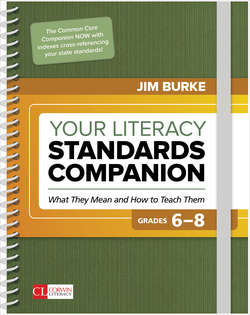Читать книгу Your Literacy Standards Companion, Grades 6-8 - Jim Burke - Страница 54
На сайте Литреса книга снята с продажи.
Common Core Reading Standard 2: Academic Vocabulary: Key Words and Phrases
ОглавлениеAccurate summary: This identifies the key ideas, details, or events in the text and reports them with an emphasis on who did what to whom and when; in other words, the emphasis is on retelling what happened or what the text says with utmost fidelity to the text itself, thus requiring students to check what they say against what the text says happened.
Analyze their development over the course of the text: This refers to the careful and close examination of the parts or elements from which something is made and how those parts affect or function within the whole to create meaning.
Conclusions of a text: In a scientific or technical text, these might be the key discoveries located at the end of the text under a heading such as “conclusions” if the article, chapter, or report follows the conventions of a scientific report or paper.
Conveyed through particular details: This refers to the way authors might explore an idea (e.g., the sense of isolation that often appears throughout dystopian novels) by referring to it directly or indirectly through details that evoke the idea of such isolation.
Determine central ideas: Some ideas are more important to a work than are others; these are the ideas you could not cut out without fundamentally changing the meaning or quality of the text. Think of the “central ideas” of a text as you would the beams in a building: They are the main elements that make up the text and that all the supporting details help to develop.
Development: Think of a grain of rice added to others one at a time to form a pile; this is how writers develop their ideas—by adding imagery, details, examples, and other information over the course of the text. Thus, when people “analyze [the] development” of an idea or theme, for example, they look at how the author does this and what effect such development has on the meaning of the text.
Distinct from prior knowledge or opinions: In the History/Social Studies standard, this phrase distinguishes objective summary (the facts of what the text says) from personal opinion (what students think, how they feel about the text, and what it says). It is an important difference given the Common Core’s emphasis on analytical thinking versus personal response.
Including its relationship to supporting ideas: Central ideas rely on the “supporting ideas” to help explore and sustain an idea or theme throughout. The writer might take an idea or theme such as the resiliency of the human spirit, for example, and build on it through examples or anecdotes, all of which complement each other as a way of developing that idea over the course of the text.
Key supporting details and ideas: Important details and ideas support the larger ideas the text develops over time. These details and ideas appear as examples, quotations, or other information used to advance the author’s claim(s). Not all details and ideas are equally important, however; so students must learn to identify those that matter the most in the context of the text.
Objective summary: This describes key ideas, details, or events in the text and reports them without adding any commentary or outside description; it is similar to an evening “recap” of the news that attempts to answer the essential reporter’s question—who, what, where, when, why, and how—without commentary.
Over the course of the text: Whether a 14-line sonnet or a 500-page novel, all texts have ideas the writer explores at length and in depth. The idea of love first introduced in the opening chapter, act, or stanza becomes a plaything in the hands of the author who looks at it from different angles, in different contexts, showing how the idea—or our understanding of it—evolves over time in the text.
Themes: This refers to the ideas the text explains, develops, and explores; there can be more than one, but themes are what the text is actually about.
